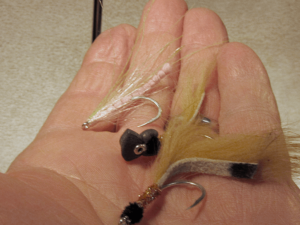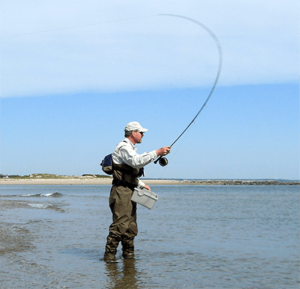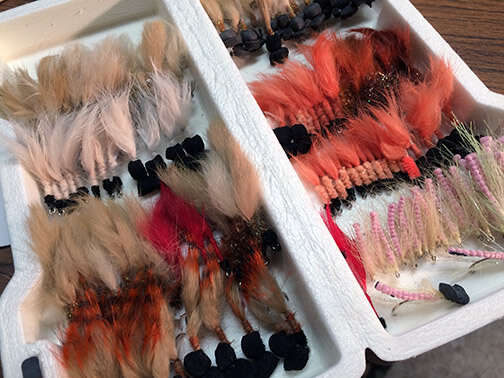By Bob Rifchin
The last striper has barely ended its annual fall migration when my friends and I start thinking about warmer waters in the coming spring. This is the time for the annual gathering of stripers for the cinder worm spawn which begins about the first week of May. When the water approaches the 60 degree mark in the shallowest and darkest of salt ponds, the conditions are ripe for localized worm populations to become active. It seems early in the season as these relatively tiny bodies of water are a new discovery for me, but I love every moment of it. Better yet, the early activity in these shallow waters makes the worm fishing last longer since the bigger bays and creeks don’t get going for another week or more. When the worms are hatching, every striper in the area seems to know about it, and they all show up for the feast.
It was a windless and unseasonably warm May afternoon and we were adrift on a mid-sized South Cape embayment when my companions thought they saw raindrops — the scene shifted in my mind to something more like hatching bugs and rising trout. This first encounter with marine worm spawns was many years ago but the memory is still vivid. As my friend and I moved closer we saw cinder worms swimming all around us. The feeding fish were all stripers, and we thought they would certainly take our baitfish patterns. How wrong we were and we quickly learned that there are few more selective fish on earth than striped bass in a “worm hatch”. We are still learning!
The timing and location of the worm activity is local and often secretive. It differs by size, species, coloration and movement of the particular worms present. For the scientific folks among you the cinder worms are Polychaetes which refers to their segmented bodies, and are of the Nereis genus. This grouping includes hundreds of species of worms including sand worms and clam worms . The literature in the scientific community describes them as 1 – 3 inches long with a head that is usually olive and a body that is pinkish. As noted before this varies quite a lot. All are burrowers though that develop paddle tails when they spawn. During this time, they swarm to the surface releasing sperm and eggs in a frenzy. Then, the adults die and the eggs sink to the bottom. The right conditions are a matter of contention including lunar phase, diurnal responses and the temperature of the mud and water.
 Regardless of all the science, in early May the most common of these creatures in my favorite waters are small (size 6 or 4 hooks) and tan or root beer in color. They swim with the tips of their tails in a stiff jerky motion. Getting the fly to look right in the water is of paramount importance, and time has proven to us that coloration differs on a location by location basis. Most scientists who have studied these worms agree that the worms move so little from their natal mud that they have developed almost like subspecies. In slightly varied environments, the same species can span a range of hues from tan to almost red but all the worms in these micro-environments will be the same. One salt pond will have tan worms and another nearby will have red ones. Permanent markers in pink and red are a must with your tan flies to adapt to conditions. You can also tie a selection in a bunch of different colors, but a successful pattern one day may not be the right choice for the next. I have hundreds of failed patterns that prove that. Also, there are often so many worms present that it is difficult to get your imitation in front of an actively feeding fish. As the years went on, we tied flies that worked subsurface most of the time and some newer versions with foam gurgler-type heads to keep them on the surface creating more disturbance as they moved. Our earliest attempts at these imitations were tied with marabou or yarn bodies, all in red with black heads but they proved far too delicate and were too flexible as well. Newer flies are more restrained in their wiggling movements and much tougher rabbit strips with the skin left attached to the fur. But on our first day fishing amid all this activity we knew nothing of how the flies needed to appear.
Regardless of all the science, in early May the most common of these creatures in my favorite waters are small (size 6 or 4 hooks) and tan or root beer in color. They swim with the tips of their tails in a stiff jerky motion. Getting the fly to look right in the water is of paramount importance, and time has proven to us that coloration differs on a location by location basis. Most scientists who have studied these worms agree that the worms move so little from their natal mud that they have developed almost like subspecies. In slightly varied environments, the same species can span a range of hues from tan to almost red but all the worms in these micro-environments will be the same. One salt pond will have tan worms and another nearby will have red ones. Permanent markers in pink and red are a must with your tan flies to adapt to conditions. You can also tie a selection in a bunch of different colors, but a successful pattern one day may not be the right choice for the next. I have hundreds of failed patterns that prove that. Also, there are often so many worms present that it is difficult to get your imitation in front of an actively feeding fish. As the years went on, we tied flies that worked subsurface most of the time and some newer versions with foam gurgler-type heads to keep them on the surface creating more disturbance as they moved. Our earliest attempts at these imitations were tied with marabou or yarn bodies, all in red with black heads but they proved far too delicate and were too flexible as well. Newer flies are more restrained in their wiggling movements and much tougher rabbit strips with the skin left attached to the fur. But on our first day fishing amid all this activity we knew nothing of how the flies needed to appear.
After that first unsuccessful exposure, we were back the next afternoon again on a rising tide and with similar weather conditions. This time, we had worm flies we copied from trout patterns made of chenille, modified in size. There was no internet available to us then to get more information quickly, but we did manage to catch a few fish. Our best results were from either drifting the flies like nymphs as we do for trout, or keeping them near the surface with short twitches. Fishing in current flows the fish roamed less and held position more like trout in a stream which gave us something familiar to look at. These flies were not long lasting and fouled frequently so the approach was soon discarded. We continued to work on our ideas for a few weeks. Then, as suddenly as the “hatch” began, it was over. There was not a worm to be found and the stripers wanted baitfish again.
The next spring it was the third week of May and my phone rang after 9:30 at night which is far from usual. It was a friend who had been out looking for stripers and found the beginnings of the worms for that season. I was not living close to the fishing at that time so I left work early, drove an hour to the Cape and launched my kayak in a small cove. To avoid spooking the fish in the shallows, stealth was necessary. Carefully the stern of my little craft was slid onto a sandbar to hold my position while casting. It was 6:00 pm and the wind which had gusted strongly all day was down. There were a few worms around but little activity. I chose a simple rabbit strip fly I developed over the winter and cinched the #6 hook tight to my 16 pound tippet. Casting to slightly deeper areas in front of me where a few fish were starting to feed, I used short inch-long twitches of the fly that made it appear lifelike among the few worms. My first cast was short, working a spot only 10 feet from the bow of the kayak, but it was met by an immediate strike that proved to be a 22 inch fish. That was followed by 4 or 5 others of almost the same size, which was better than I expected in such a small area. The number of worms seemed to be increasing quickly when I noticed a small movement of water in a tiny tongue of current about 20 feet away. The tide was dropping and it was likely the fish would move soon but cast after cast my offering was ignored. The fish moved a lot of water with each natural it consumed, and finally it found my fly among the now hundreds of worms.
 As I strip-set the hook, the fish hesitated then ran toward the mouth of the cove. I rocked the kayak free of the sand, and began paddling quickly with my left hand. The fish was pulling me and my little craft out of the cove and as we gained speed the paddle became a rudder. I prayed aloud that the leader would hold as the Nantucket sleigh-ride continued for several minutes. Finally the kayak was alongside the striper, a great fish which measured 42” that I carefully revived and released. By then, it was pretty dark and as I deployed my lights it became obvious that we were in the middle of the bay at least a half-mile from where we had started. It had all been kind of a blur of time and space. I paddled back to my truck, as anything else that night would have been anti-climatic. One thing should be noted however lest it be overlooked. The sparse number of worms at the beginning of this night helped me get my imitation successfully in front of more fish.
As I strip-set the hook, the fish hesitated then ran toward the mouth of the cove. I rocked the kayak free of the sand, and began paddling quickly with my left hand. The fish was pulling me and my little craft out of the cove and as we gained speed the paddle became a rudder. I prayed aloud that the leader would hold as the Nantucket sleigh-ride continued for several minutes. Finally the kayak was alongside the striper, a great fish which measured 42” that I carefully revived and released. By then, it was pretty dark and as I deployed my lights it became obvious that we were in the middle of the bay at least a half-mile from where we had started. It had all been kind of a blur of time and space. I paddled back to my truck, as anything else that night would have been anti-climatic. One thing should be noted however lest it be overlooked. The sparse number of worms at the beginning of this night helped me get my imitation successfully in front of more fish.
A few days later it was time for us to go back to that same cove on foot. We found a few fish feeding and worked hard to cover as much water as possible. There’s a lot of private property in that area which makes access difficult. It was in the process of working around that marshy area that we stumbled on a small acre salt pond with one outlet to the bay. Though the pond was very little it was full of feeding stripers. The fishing was very good. When the action was over, the only difference found was the smaller body of water was a bit cooler as there was a spring-fed area. The temperature must have delayed the “hatch” by a few days. We’ve learned that generally ponds and even bays with small outlets that do not drain completely on each tide tend to have longer lasting spawns, but temperature is a factor that needs to be watched. Also, if you are ready for the lack of sleep involved, false dawn the morning after a large spawn will often find stripers cruising areas where dead or dying worms injured during the night are carried by the current, and they are feeding actively on baitfish that have congregated there.
Most anglers think this worm activity is only a spring phenomenon and for some species of worms that is true. However, there are other worms in the marine environment active at other times. I’ve encountered some in very early spring before the stripers arrived to eat them and occasionally located some nice white perch as a result. Other worm populations have been spotted at warmer times of the year, often after small bays have become so warm that stripers have left them until fall. These appear to be Neris virens (sand worms) and Neris succinea (clam worms) which in our locale seem to appear later. There have been some in winter (look like virens) as well along shallow beach fronts that were locations where cold weather populations of cod once fed. This past fall, fishing creek outlets for the last of the migrant fish, we caught bass on Clouser minnows and hooked sandworms as well. I wonder if worm flies would work there?



